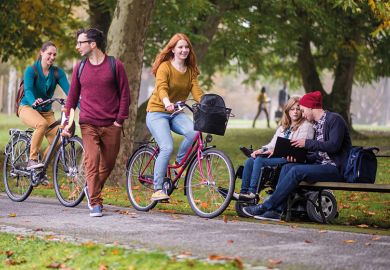I can’t count how many open days I’ve worked in nearly 20 years as a lecturer. But this summer I’ve seen things from the prospective student’s side.
Firstly, a bit of background. My daughter is predicted three A* at A-level, has many interests and no clear career goal. We looked at 12 universities and attended subject talks in ancient history, criminology, law, philosophy, psychology and zoology at Oxbridge, Russell Group, 1960s and post-1992 universities.
We travelled by electric car, which meant some very early mornings and late nights with charging times factored in. We also had hotel bills and meals out: it’s been a significant investment in time and money. Needless to say, I rapidly evolved into a canny consumer of open day visits.
So here are my top 10 dos and don’ts for universities to keep in mind for open days:
1. Signage: have some. Signs on the roads and a few arrows from car parks or bus stops can help everyone arrive happy and excited, instead of worried they have come on the wrong day to the wrong campus. If shuttle or parking services are free on open days, put up signs stating so. One university stationed student ambassadors in the car parks with giveaway maps – very thoughtful.
Don’t, however, have student ambassadors become the signs. One urban university sorted signage problems by fitting ambassadors with giant tear-drop marketing banners. These sprouted from their backs in large steel-framed harnesses. It didn’t exactly scream respect for the student population.
2. Do show off any green credentials. Recycling bins, vegan food options, un-mown areas, solar panels, living roofs, etc., were big pluses for my daughter. She turned up her nose at an extremely prestigious programme because the campus had no recycling, no vegan sarnies and the pavements were thick with cigarette butts.
Don’t pretend that the climate catastrophe and Brexit are not happening and that prospective students will be studying and graduating in today’s economic landscape. Students and parents seemed to prefer university staff who were frank but upbeat about upcoming challenges.
3. Do give lecturers cheat sheets with typical offers, employment statistics, etc. These are always the first questions asked and current information should be to hand. Do not apologise for module options not being available every academic year – explain that your staff will at times be working on their 4* research and leave it at that. Students get it.
4. Don’t put your dullest or most ill-prepared lecturers on open day duty. I saw amazing talks, but also some right shockers. One philosophy lecturer was late, hadn’t showered, talked down to us, was dull and ended with some casual sexism. The scope and breadth of his failure was awe-inspiring. A very nervous law lecturer was knowledgeable, but had a totally flat delivery. Even with free coffee in hand, I found myself getting sleepy.
The best speakers were research staff with administrative roles as admissions officers for the degree or department. This seemed a good way to ensure that effective open day staff received workload credit for their service.
5. Do think about people with undisclosed disabilities. Free shuttle buses on the day are excellent dos. A four-storey parking garage with no lift or a quarter-mile walk up a steep hill to the check-in station are big don’ts. Ensure lifts and disabled loos work without keys on the day and are clearly signposted.
If someone is sitting on the end of a row in a busy lecture, they might need to sit there. Don’t insist they move in, just ask them to let in others.
Don’t joke about unfitness in talks. Fitness is not always a choice.
6. Don’t insist on online registration but then ignore it on the day. My daughter was outraged by her wasted time. Especially in urban environments, don’t have zero security on the day – or at least provide signage about “normal” security measures that have been suspended.
7. Accommodation: don’t do a one size fits all approach or assume all students are party animals. Do talk about quiet blocks, college ethos, etc. Please ensure quiet blocks aren’t also the most expensive accommodation. Poor students can value sleep and study time just as highly as rich students.
8. Let your students show off. My daughter was charmed by a pole dancing society that she felt showed body positivity and inclusivity. She also liked a house plant society, watched cheerleaders, chatted with student ambassadors, valued talking to students on subject tables, and loved it when students took questions in the subject talks.
9. Don’t talk a good game about inclusivity, but have all-white student ambassadors and fill all your cafe sandwiches with pork. These are bright kids and they will notice. They will also notice Eurocentric curricula and all-white reading lists.
Many open days are in June and July – mentions of pride events mean a great deal to many prospective students.
10. Do keep enthusiastically communicating the benefits of higher education. Our open day tour helped my daughter decide her degree, made her feel more confident about money matters and gave her a feel for where she would be most happy. As a sector, we nailed it.
Mimi Thebo is reader in creative writing at the University of Bristol and a multi-Carnegie medal nominee in children’s fiction.
Register to continue
Why register?
- Registration is free and only takes a moment
- Once registered, you can read 3 articles a month
- Sign up for our newsletter
Subscribe
Or subscribe for unlimited access to:
- Unlimited access to news, views, insights & reviews
- Digital editions
- Digital access to THE’s university and college rankings analysis
Already registered or a current subscriber?



